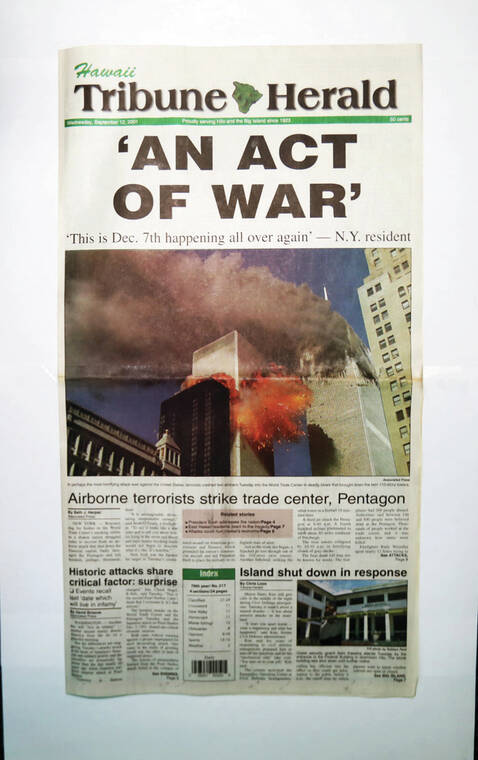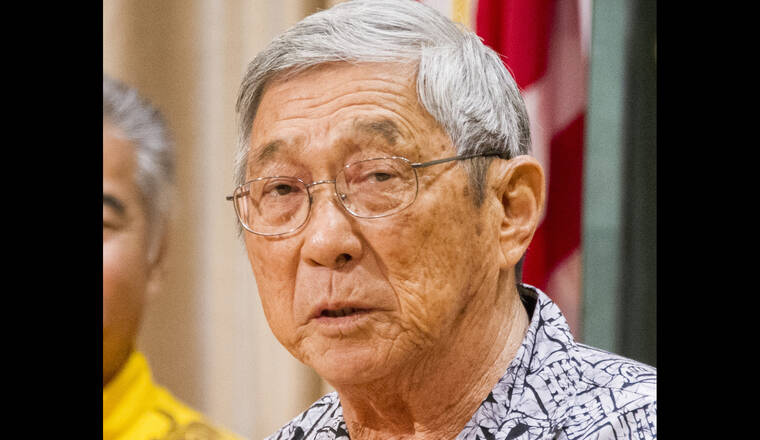Hawaii Island is almost 5,000 air miles from New York City, but when four commercial aircraft hijacked by terrorists crashed into the World Trade Center, the Pentagon and a Pennsylvania field on Sept. 11, 2001, shock waves resounded across the world, including here.
“It’s changed us in so many ways,” said Harry Kim, who was mayor on that fateful Tuesday. “Every time I go to the airport, they’re there with the security because of that.
“People used to go up to the airport gate with their leis to say hello or goodbye to people as they boarded or got off the plane. People 20, maybe 30 years old, they don’t remember that. But it used to be a huge thing for us, and it’s a big change in our lifestyle.”
Kim, who was Hawaii County’s Civil Defense administrator for 24 years before becoming mayor in 2000, said he had arisen at about 4 a.m. that day, and his phone rang.
“The person on the other end of the phone was a very, very soft-spoken woman,” Kim recalled. “She said, ‘Is this Mayor Kim?’ I said, ‘Yes.’ She said, ‘Are you aware what’s going on?’ And I said, ‘No, I’m not aware.’ She said, ‘Please turn on the news, and please know that we await your guidance.’
“In a very calm, very soft tone I can still hear in my head today, ‘We await your guidance.’ And then, she hung up.”
Thinking the call might be a prank, but not wanting to take chances, Kim turned on the television.
“The news and the information at that point was really scattered, but I thought, ‘This is really bad,’” he said. “So I put my clothes on and went to work.”
Kim then called police dispatch, who told him they had been trying to reach him. After activating Civil Defense, Kim took to the radio airwaves at 5:45 a.m. to announce that Big Island schools were closed for the day.
“And I meant all schools — public schools, private schools and the (University of Hawaii) system,” he said. “It was the time that teachers go to school and students go to school. I didn’t want the roads full of traffic and children waiting at bus stops.
“And I thought it was a time families need to be together.”
The only other schools in the state that closed for the day were those on Oahu military installations.
The mayor also met with his cabinet.
“I told them, ‘The information I have is very sketchy. But I do know this — this country is at war. I don’t know what the outcome will be, but you do not attack us and kill so many of America’s people and we do not go to war.’ These were Pearl Harbor numbers.
“And I told them the most important thing is this: ‘You must maintain calm. You must project control of the situation. And you are at work.’
“There are times that the people of Hawaii and the United States need our government. This was one of those times.”
While the title is strictly unofficial, B97/B93 morning radio personality Darrin “DC” Carlson has presided as mayor of the Big Island’s airwaves since 1985. On 9/11, he was doing the morning show on KBIG-FM with then-on-air partner Israel Gonzales, and was scheduled to broadcast all week from the former Borders bookstore in Kailua-Kona.
“We realized we needed to run down to the (Kona) studio, because this was a serious situation, and here we are sitting out with books, and that just wasn’t right,” Carlson said. “So we started taking calls — and they were all really emotional calls. There was only one other time I remember when people were that emotional on the phone, and that was when (Space Shuttle) Challenger exploded.”
Carlson recalled one distraught caller, a woman who had no one else to talk to but needed to unburden herself.
“Israel and I looked at each other and went, ‘Wow!’” he said. “Instead of staying in Kona all week, we came back home that day when our show was done. We just wanted to be at home with our families.”
Hilo-born chef Roy Ellamar became a culinary brand with the restaurant Harvest by Roy Ellamar in the Bellagio Las Vegas, but on Sept. 11, 2001, he was sous chef at the Four Seasons Resort Hualalai in Kona.
He, James Cassidy, the Four Seasons’ executive chef, and James Babian, executive chef at the Orchid at Mauna Lani, had cooked the night before for the Hawaii Visitors and Convention Bureau’s dinner at the prestigious James Beard House in New York City.
Ellamar said an early sightseeing trip including the Statue of Liberty and the observation deck at the World Trade Center was on the agenda for the morning of 9/11.
“But it’s New York, and you go out after doing a successful dinner,” Ellamar recalled. “We ended up falling asleep late.
“I remember waking up, and there were sirens. It was in midtown, and I remember the sirens were just so crazy. I was thinking, ‘Man, this town.’ But it was my first time in New York City, so I don’t know any different. I was just thinking this was insane, how noisy it is. I didn’t know that the plane had already hit the first tower and that’s what was going on.
“It was a good thing we slept in.”
The chefs, unable to leave New York, rolled up their sleeves, gave blood, then returned to the James Beard House, across from St. Vincent’s Catholic Medical Center — the closest hospital to Ground Zero — and worked with other volunteers to cook meals for first responders, all with donated food.
“It was great because all the big restaurants like Daniel and Jean-Georges, all of them ended up sending down food because they were closed, obviously, and we were just putting together the ingredients, cooking with a lot of other chefs and doing what we could,” Ellamar said.
“Since we were just there on Monday night to promote Hawaii, we felt we could help by preparing warm meals with aloha,” Babian, now chef-owner of Pueo’s Osteria in Waikoloa village, told the Associated Press at the time.
Hilo residents Kathy Frankovic and Hal Glatzer were a New York City-San Francisco bicoastal married couple the day terror descended from the sky.
Frankovic was director of surveys for CBS News and at home in their Manhattan apartment, about a 10-minute walk from CBS News’ West 57th Street headquarters.
“I had the TV on and was watching the images of the World Trade Center, and you could see when the second plane hit,” Frankovic said. “This was being broadcast live, at least within New York City. … From that point on through the next week, for us in the news business, our time was totally full. I’d get home at 2:30 in the morning, and I’d leave again for work at 7 o’clock in the morning. And this was all week long.
“I do public opinion research. We had to see how America was responding to this, and we did surveys that had a lot of questions that let people put their answers in their own words so we could use it and we could understand it. I had friends that worked in the control room, who were viewing all the footage that was shot of the World Trade Center area — of the buildings collapsing, of everything else. One of them told me that she’s taking in the feeds, she’s looking at everything, she’s watching everything. She leaves the control room and goes to the ladies room and she throws up. And then she walks back into the control room and she keeps working.”
Glatzer, an author and former Tribune-Herald reporter, was in San Francisco, almost 2,600 miles from New York, but he and Frankovic had a phone conversation on Sept. 11.
“I was talking with Hal, and he was going to go to a meeting downtown near the (Transamerica) Pyramid building,” Frankovic recalled. “And I’m saying to him, ‘Don’t go. Don’t go there. Don’t go.’”
Added Glatzer, “As you listened to the news in San Francisco, there were a lot of warnings. ‘Don’t go downtown. If this could happen in New York, there’s no reason why it couldn’t happen here.’ I mean, the fact that it didn’t and it probably wouldn’t have didn’t make any difference. That was the tenor of the newscasts at the time.”
Frankovic said that on Friday, Sept. 14, 2001, she walked to Times Square.
“There was a billboard, I’ll never forget, that had not been taken down that should’ve been taken down the next day. It said, ‘We have a lot of stories, just like the World Trade Center.’ … And you walk through Times Square, and there are lots of restaurants at 7 o’clock on a Saturday night that should’ve been full of people, and they were empty. And the waiters were standing in the doorways, having a cigarette.
“And it struck me that this was devastating in a way I hadn’t thought about, which was devastating to the world of New York City. Because people were not coming in through the bridges, through the tunnels. They were not spending the money they normally would to keep the city alive.”
After visiting her mother in New Jersey on Sunday, Sept. 16, Frankovic returned home to Manhattan.
“All of a sudden, I felt so much better,” she said. “And the reason was, this wasn’t a tourist spot; this was a neighborhood. And people were outside. They were at restaurants; they were at bars. They were talking to their neighbors. They were talking to their friends. There was still a community, and there was still life going on. And I’m sure that was happening in every other neighborhood in New York City. People were devastated, but people are resilient. They were going to go on with their lives.
“And that’s when I knew it was going to be OK.”
Email John Burnett at jburnett@hawaiitribune


